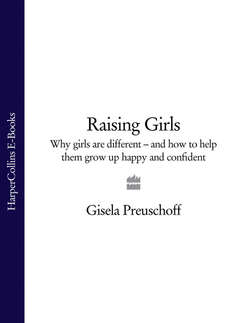Читать книгу Raising Girls: Why girls are different – and how to help them grow up happy and confident - Gisela Preuschoff - Страница 31
ОглавлениеTHREE HER EARLY YEARS
In this chapter we will look at important areas of little girls’ development, and see how parents can help this development. Again, the fundamental points here are that you should know what your own beliefs are, you should stick to them, and you should observe your daughter carefully and lovingly as often as possible so that you will know what she needs.
Language development
One area in which little girls are usually ahead of little boys is language development. According to one study, while girls can already speak three words at the age of ten months, boys the same age can only manage one.1 At the age of eighteen months, half of all girls have a vocabulary of 56 words at their disposal, while half of all boys use only 28 words.
These differences also appear in their passive vocabulary (that is, the vocabulary they understand but do not use themselves). At sixteen months, half of all girls understand 206
words, while half of all boys are getting by with 134 words. Boys catch up to girls around the age of 20 months.
So overall, girls have greater language fluency: their left cerebral hemisphere is activated earlier, and this is where the language centre lies. This brings us back to the differences between the male and female brain. Interestingly, parents tend to respond to this difference quite unconsciously, encouraging their daughters’ speech habits more strongly than their sons’. An American investigation showed that the number of words parents direct to their child – in other words, the amount of communication they initiate – gives a fairly precise prediction of a child’s intelligence, academic success and social skills.2 The more words, the greater the child’s ability in these areas.
Without a doubt, speaking stimulates the brain and assists in building connections that are indispensable to a child’s intelligence, creativity and adaptability. The language acquisition phase is therefore shaped by interaction – a link that becomes far more noticeable during the following years.
One language or two?
If you are in a position to bring up your child bilingually, do it. Young children are able to acquire language very easily and naturally in the first few years of life – and it is never again so easy for them. This ability not only leads to an improvement in your child’s competency in her first language, it also has a positive effect on her overall intelligence.
